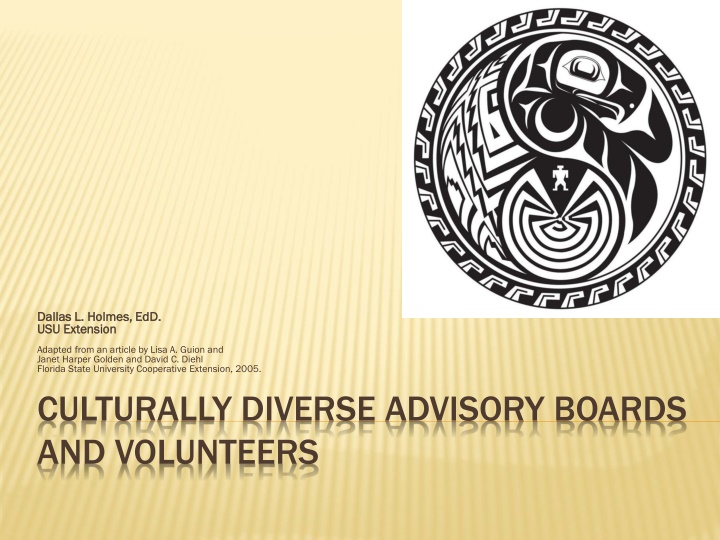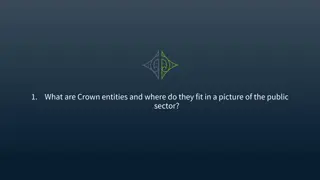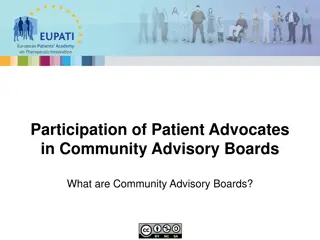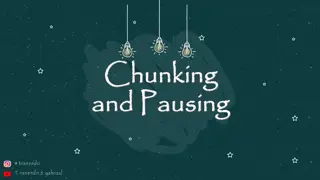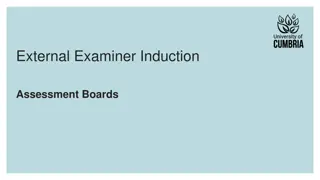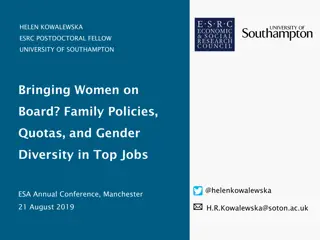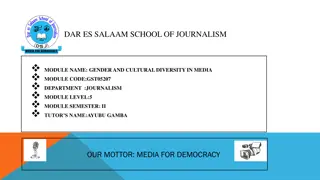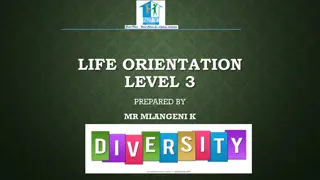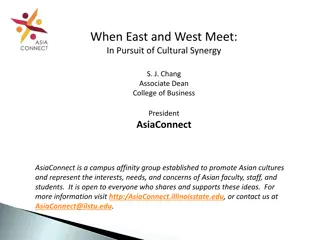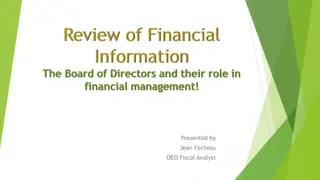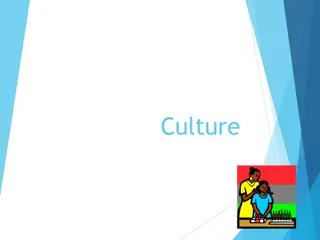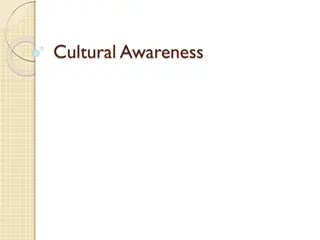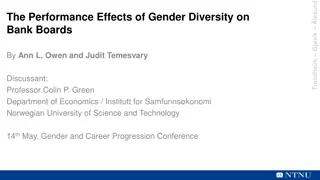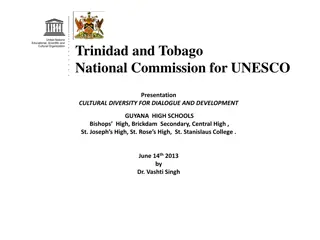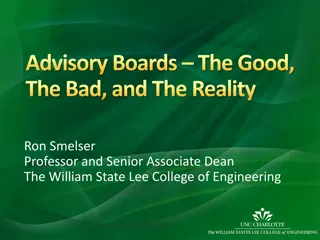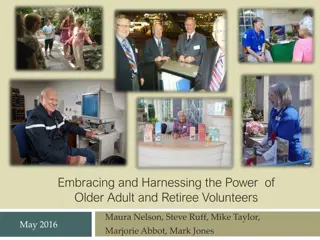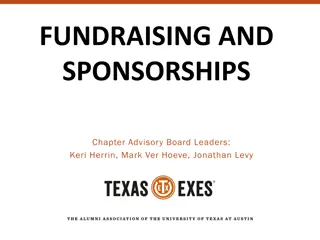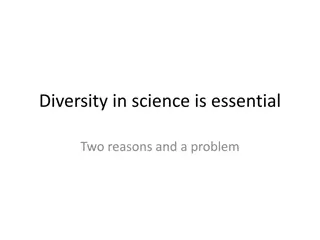Embracing Cultural Diversity in Advisory Boards and Volunteers
Encouraging cultural diversity within advisory boards and volunteer teams enhances program effectiveness and fosters inter-community relationships. By selecting members reflective of diverse demographics and employing cultural guides, Extension units can ensure inclusivity and relevance in their activities. It's crucial to approach cultural guides with equality and avoid tokenism for genuine multicultural representation and understanding.
Download Presentation

Please find below an Image/Link to download the presentation.
The content on the website is provided AS IS for your information and personal use only. It may not be sold, licensed, or shared on other websites without obtaining consent from the author.If you encounter any issues during the download, it is possible that the publisher has removed the file from their server.
You are allowed to download the files provided on this website for personal or commercial use, subject to the condition that they are used lawfully. All files are the property of their respective owners.
The content on the website is provided AS IS for your information and personal use only. It may not be sold, licensed, or shared on other websites without obtaining consent from the author.
E N D
Presentation Transcript
Dallas L. Holmes, EdD. Dallas L. Holmes, EdD. USU Extension USU Extension Adapted from an article by Lisa A. Guion and Janet Harper Golden and David C. Diehl Florida State University Cooperative Extension, 2005. CULTURALLY DIVERSE ADVISORY BOARDS AND VOLUNTEERS
CULTURALLY DIVERSE ADVISORY BOARDS AND VOLUNTEERS Inviting members of diverse communities to participate in the programming and planning of Extension activities is a good step toward building inter-community relationships. People with different backgrounds bring strength to the quality of the Advisory Board. Volunteers with different backgrounds make the programs more effective and relevant to a greater segment of the community.
INVITING ADVISORY BOARD PARTICIPATION To encourage diversity, Extension units should choose Advisory Board members that mirror the demographics of the county. Advisory Board membership invitations and letters should be formal and provide detailed information on board activities, expectations and benefits. Provide an orientation to new board members about Extensions current objectives and directions. Document invitations, contacts and attempts to populate the Advisory Board with diverse members.
CULTURALLY DIVERSE ADVISORY BOARDS AND VOLUNTEERS CULTURAL GUIDES Culturally diverse volunteers and Advisory Board members are also effective as Cultural Guides Cultural Guides can highlight traditions, belief systems, and other elements of a culture that may be unfamiliar to Extension educators
CULTURALLY DIVERSE ADVISORY BOARDS AND VOLUNTEERS CULTURAL GUIDES Cultural Guides can lead Extension educators to the gatekeepers of their community. Religious authorities Prominent business people Respected leaders
CULTURALLY DIVERSE ADVISORY BOARDS AND VOLUNTEERS CULTURAL GUIDES It is vital to approach a Cultural Guide from a position of equality and mutual assistance. Avoid tokenism The selected Cultural Guide is the only individual of their community represented and should be regarded as the Extension s steward for multiculturalism.
CULTURALLY DIVERSE ADVISORY BOARDS AND VOLUNTEERS CULTURAL GUIDES Individuals who are viewed by another community as formal leaders are not always regarded as such in the community they represent. Find more than one Cultural Guide from each group that needs representation. Mohandas Gandhi was not an official political leader. Queen Victoria was considered the Queen of India. Which did the people of India listen to?
CULTURALLY DIVERSE ADVISORY BOARDS AND VOLUNTEERS CULTURAL GUIDES Cultural Guides are helpful to educators in: Selecting activities and learning experiences that will be most effective and beneficial Designing marketing approaches Recruiting other volunteers from the community Planning how lessons are taught Maximizing learning style preferences
CULTURALLY DIVERSE ADVISORY BOARDS AND VOLUNTEERS Our Advisory Boards and Volunteers should be representative of the communities that we serve. Cultural Guides help to make our programs relevant to clientele.
AN EXAMPLE OF USING CULTURAL GUIDES EFFECTIVELY DIABETES EDUCATION IN THE LATINO COMMUNITY Conducted by Ann Henderson, Family and Consumer Science Extension Educator in Box Elder County
DIABETES EDUCATION IN THE LATINO COMMUNITY In order to meet the needs of the Latino population Father Schoeppe [The local Catholic Priest] invited six men and women from the parish to meet with us and help us plan the class. This group discussed the format of the class, meeting days, times, and locations, how to publicize the class, and whether measuring height, weight, waist and hip circumference, blood pressure and hemoglobin A1c would be accepted.
DIABETES EDUCATION IN THE LATINO COMMUNITY Elsa, the secretary from the church, continued to work with us. The church provided the facilities for the class. Elsa personally contacted those who were interested in the class and prepared announcements for the church bulletin. She also helped translate a flyer that other committee members delivered [all over the city]. . . Elsa also attended each class and called participants to remind them about the classes and sometimes provided rides for participants. . . . One of the key factors that made this program successful was having Elsa work with us and guide us. She served as our cultural guide. She provided an essential link to the Latino population and helped us reach the population.
REFERENCES Guion, L. A., Goddard, H. W., Broadwater, G., Chattaraj, S., & Sullivan- Lytle, S. (2003). Strengthening programs to reach diverse audiences. Gainesville, FL: Florida Cooperative Extension, University of Florida. Lynch, E., & Hanson, M. (1997). Developing cross-cultural competence (2nd ed.) Baltimore, MD: Paul H. Brookes. Nash, K. (1999). Cultural competence: A guide for human agencies. Washington D.C: Child Welfare League of America Press. Robinson, T.L. & Howard-Hamilton, M. F. (2000). The convergence of race, ethnicity, and gender: Multiple identities in counseling. Upper Saddle River, NJ: Prentice Hall
